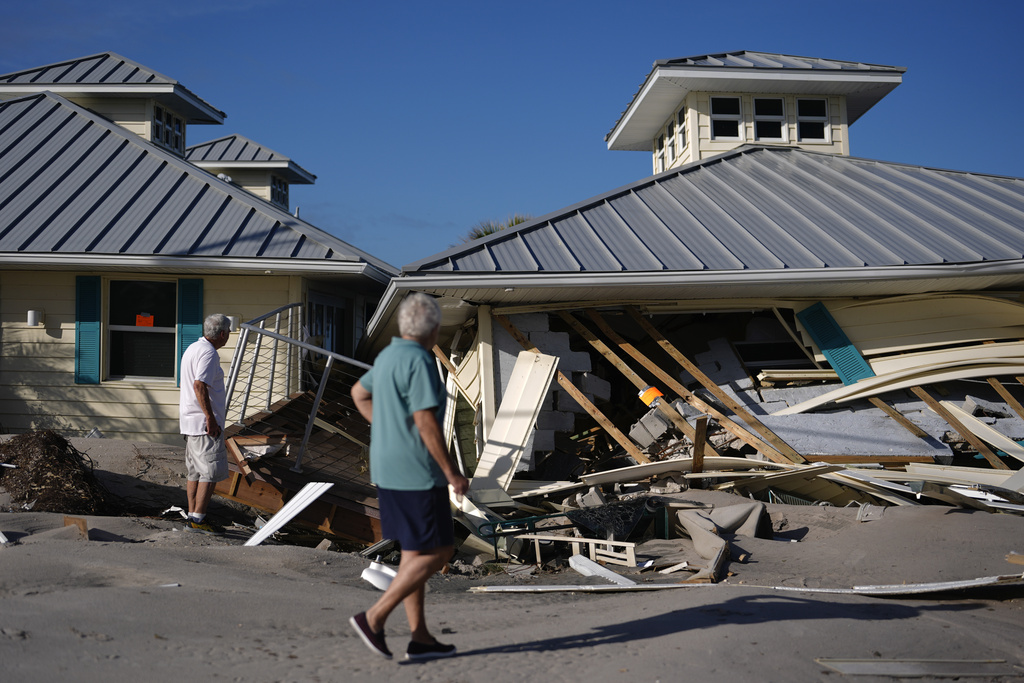Navigating Insurance Claims After Hurricanes Helene and Milton \ Newslooks \ Washington DC \ Mary Sidiqi \ Evening Edition \ As Florida and the Southeastern U.S. begin recovering from the devastation caused by Hurricanes Helene and Milton, homeowners and businesses are facing the challenging process of filing insurance claims to rebuild. Experts advise understanding your policy, documenting everything meticulously, and exploring additional resources if insurance falls short. Despite the potential complexities, proper preparation and a calm approach can ease the path to recovery.
Insurance Claims After Hurricanes Helene and Milton: Quick Looks
- Understanding policies: Know your coverage limits, exclusions, and deductibles to determine if filing a claim is worthwhile.
- Documentation is key: Keep detailed records of damages, expenses, and interactions with adjusters to support your claim.
- Seek professional help: Public adjusters or attorneys can assist if disputes with insurers arise.
- Alternative aid: Explore government programs like FEMA and the SBA for additional assistance if insurance coverage is insufficient.
Deep Look
The threat from Hurricanes Helene and Milton may have subsided, but the recovery journey is just beginning for millions of homeowners and business owners across Florida and the Southeastern U.S. As they start to rebuild, many are now faced with navigating the complex world of insurance claims to cover their losses. With extensive damages across several states, the combined private insured losses from both hurricanes could reach $55 billion, according to Moody’s RMS, a risk management firm.
Understanding the Emotional and Practical Challenges of Filing Claims
“After a disaster, you’re just glad to be alive, but then comes the tough part: dealing with the business side of it,” said Don Hornstein, an insurance law expert at the University of North Carolina. Many survivors are finding themselves caught between securing basic needs and beginning the long process of filing claims.
Helene, a Category 4 storm, was the deadliest hurricane to hit the U.S. mainland since Katrina, causing widespread flooding, property damage, and at least 246 fatalities. Hurricane Milton, a Category 3 storm, followed two weeks later, claiming 11 lives and unleashing a wave of destruction, particularly across coastal communities.
Insurance Realities: What Policyholders Need to Know
For homeowners and businesses, insurance claims are crucial to rebuilding, but many people are unprepared for the complexities that often arise. “You may think you’re covered for everything, but that’s not always the case,” explained Amy Bach, executive director of the consumer advocacy group United Policyholders. She noted that understanding the specifics of your policy is essential, particularly regarding coverage limits, deductibles, and exclusions.
Many property owners may not realize that standard home insurance policies typically cover wind damage but often exclude flood damage, a key issue after storms like Helene. For those unsure of their coverage details, seeking clarification from insurance agents or brokers is the first step. Filing claims promptly is also important, as deadlines are generally about 60 days from the date of loss.
The Fine Print of Coverage: Wind vs. Water Damage
One of the most challenging aspects of insurance claims after hurricanes involves distinguishing between wind and water damage. Helene was primarily a flood event, whereas Milton caused significant wind damage, including disputes over what constitutes “wind-driven rain.” Hornstein pointed out that the line between wind and water is technically clear, but policyholders may still face complications. “If the house was simultaneously destroyed by flood and wind, it’s generally not covered by private insurance,” he said, highlighting the importance of flood insurance.
Business owners should also check for business income or business interruption insurance, which covers lost revenue and certain expenses when a business is forced to close due to storm damage. Understanding what your policy includes can help you determine whether filing a claim is worthwhile, as small payouts may not justify the potential increase in premiums or long-term implications on your claims history.
Documenting Everything: Essential for a Successful Claim
Effective documentation is critical when filing an insurance claim. Property owners should take photos and videos of damages, both before and after cleanup efforts. Detailed records of repair expenses, evacuation costs, and other unusual expenditures related to the storm should be maintained, especially for businesses. Steve Powell, executive vice president at claims management firm Sedgwick, advised, “Keeping a record of all incurred costs can significantly bolster your settlement claims.”
After submitting a claim, an insurance adjuster will be sent to assess the damage. While frustrations can run high during this process, experts like Lawrence White, an economics professor at NYU, emphasize the importance of remaining calm and cooperative. “Try to be as reasonable as possible. The adjusters are likely stressed too,” he said. If discrepancies or disagreements arise, property owners can consider hiring a public adjuster to get a second opinion and assist in negotiations with the insurer. However, be mindful of the fees they charge and check their references.
Making Decisions: Repair, Appeal, or Legal Action
Once an insurance payout is offered, property owners should carefully consider whether to accept it or appeal. Understanding your rights and the deadlines for accepting payments or filing appeals is crucial. It’s also important to know that claims can be updated if more damage is discovered during repairs, but there are limits on how long claims can be reopened.
Should disputes with insurance companies drag on, hiring an attorney might become necessary. Legal battles over insurance claims can be time-consuming, sometimes stretching for over a year. Charles Nyce, a professor of risk management at Florida State University, said, “About 90% of insurance claims are settled without escalating to court, but having legal representation can help when negotiations stall.”
Exploring Alternative Aid Sources
In situations where insurance falls short or is not available, federal assistance programs can provide much-needed support. The Federal Emergency Management Agency (FEMA) offers grants for home repairs and replacements for eligible applicants, while the Department of Housing and Urban Development (HUD) provides certain grants for hurricane survivors. The Small Business Administration (SBA) also offers low-interest loans to renters, homeowners, business owners, and nonprofits affected by natural disasters. However, these programs come with their own eligibility criteria, and the application process can be as intricate as filing an insurance claim.
The SBA has warned that it is running low on funds to support disaster recovery loans unless Congress intervenes to replenish its budget. This uncertainty adds another layer of complexity for those already facing the daunting task of rebuilding their lives and businesses after back-to-back storms.
Personal Stories Highlight Challenges of Recovery
For people like Rhoda Moehring, a 86-year-old property owner in Steinhatchee, Florida, the road to recovery is filled with uncertainty. Moehring, who owns multiple rental properties damaged by flooding, expressed her skepticism about the insurance process. “I usually get zip with these things,” she said. “Was I insured for that? No, sorry, you weren’t. It goes on and on.”
Moehring relies on her son to navigate the claims process, reflecting a common struggle among those unfamiliar with the intricacies of insurance coverage. Many hurricane survivors find themselves facing similar obstacles, as they sift through policies and legal jargon while grappling with the immediate realities of loss.
Expert Recommendations: Steps to Take After a Natural Disaster
- Act promptly: Contact your insurance agent or broker as soon as possible. Familiarize yourself with the policy’s details, including coverage limits and deductibles, to decide if filing a claim is beneficial.
- Document damages: Take detailed photos and videos of all damages before making repairs. Keep records of any expenses incurred during evacuation or as part of temporary repairs.
- Stay calm during inspections: Work cooperatively with adjusters. If you disagree with the assessment, consider hiring a public adjuster for a second opinion.
- Review and negotiate: Understand your rights regarding the insurance payout. Explore options to appeal if you believe the offer is insufficient.
- Consider legal support if necessary: Seek legal advice if disputes continue, but be aware of the costs and potential delays involved.
- Look into alternative aid: Explore government programs like FEMA grants and SBA loans for additional financial support if insurance coverage is inadequate.
The hurricanes’ immediate threat may have passed, but for millions across the Southeastern U.S., the arduous journey of recovery is just beginning. Whether through insurance claims or government assistance, understanding the available options and approaching the process strategically can make all the difference.
Navigating Insurance Navigating Insurance Navigating Insurance







